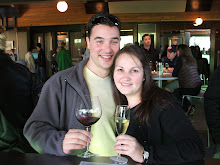Now that I have given you a few suggestions of wines to try, I thought it would be a good time to give you some pointers on how to Appreciate your wine to the fullest. After you get a few suggestions from your friends, the wine clerk, or most importantly me :-), you take your wine home and let the games begin...
A. If it is a white wine or sparkling, you will chill it, and if it's red you'll want to keep it at around 55 to 60 degrees, just below room temperature.
B. When you are ready to serve, open your red and pour it at least 10 minutes before you are going to drink it. Most reds will benefit from being in contact with the air for a bit (there are some exceptions in really cheap, crappy wines, but we won't go there on this blog!)
1. SEE THE WINE - This is your first step in appreciation. Swirl it around in your glass, notice the color, is it yellow-gold? is it pink? is it light ruby? is it dark purple? Notice the rim or very edge of the wine, if it is older, it will have a darker, brownish hue, younger wines will maintain the same color throughout it's entire body. Is the wine clear? The answer to these questions can tell you so much about the wine before you even get to step 2...
2. SMELL THE WINE - This is where so many people miss out on the true appreciation of what they are drinking. I'm sure you've heard it before, but I can't say it enough, most of your wine appreciation will come through your sense of smell in one way or another. We only taste 5 or six different senses, but our sense of smell is what gives us the great opportunity to enjoy and describe a beverage, all made from grapes, in so many differing and exciting ways. Now when you first start tasting and appreciating wine, it probably will just taste like fermented grape juice... But your sense of smell will open up a whole new world, so get creative and sniff before you sip and think before you gulp.
3. SIP THE WINE - Take it in for the 3rd step. Let the wine touch every part of your mouth, the tip of the tongue to find any sweetness and residual sugars, the middle probably won't get much since wine does not contain particularly salty components, the sides and back of the tongue will sense the acidity. A good wine should have the perfect balance between sweetness (fruit) and sourness (acidity). And finally the very back of the tongue and gums and cheeks will sense the tannins as a drying effect. Tannins are a main ingredient in wines that are meant to age, high tannins = lasting wines, low tannins = drink now.
Since the sense of smell is so versatile, you will also be using it to describe how the wine tastes. Although it is important to note the sweetness and acidity, doesn't it just sound nice to say a wine tastes like mushrooms, wet leaves, and tar??? Ok, not so much to me, but some people actually like that, go figure.
One other important "tasting basic" to note is the decision to Spit or Swallow... The decision will depend solely on your purpose for tasting the wine and only you can decide what you will do and when you will do it. If you are enjoying your wine with a meal, chances are you are going to drink it down and enjoy every last drop! However, if you are tasting in a class, something I will be doing very soon, you will be going through many wines, and cannot consume too much alcohol, otherwise you won't be able to appreciate all the subtle nuances in some of the later wines.... So though I do love to enjoy my wine and drink it down, there is always a time and place to spit it out.
Subscribe to:
Post Comments (Atom)

No comments:
Post a Comment